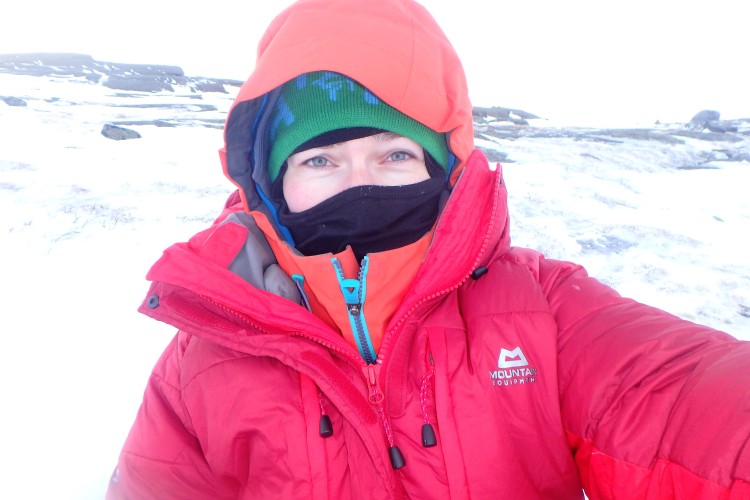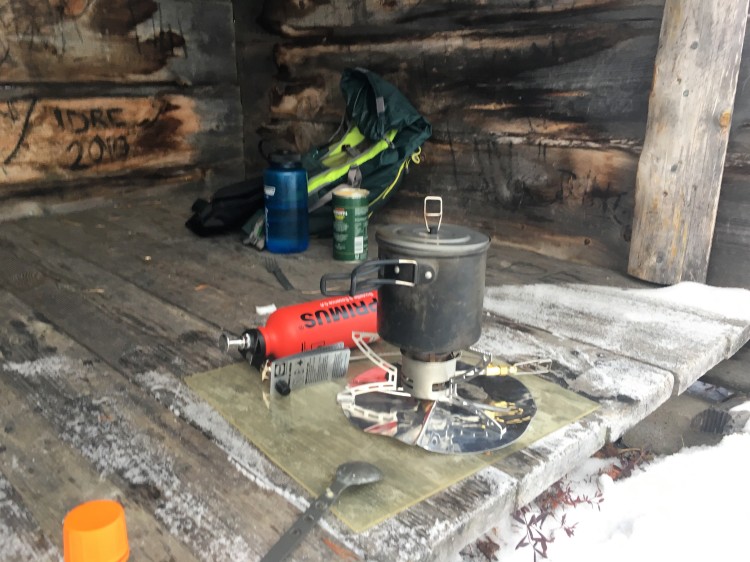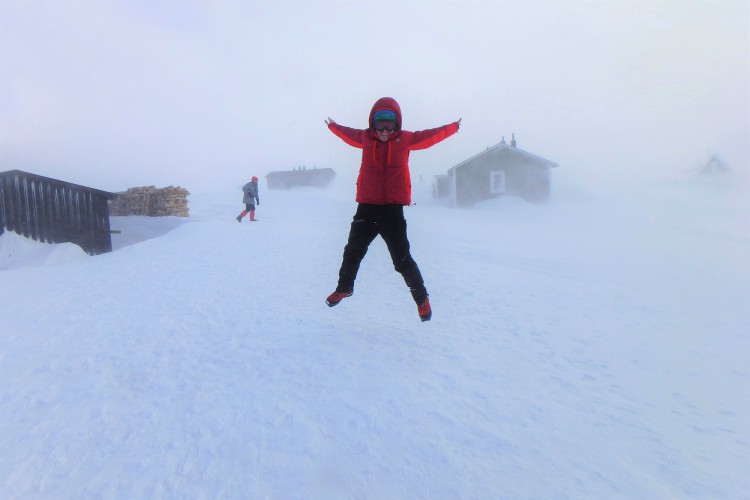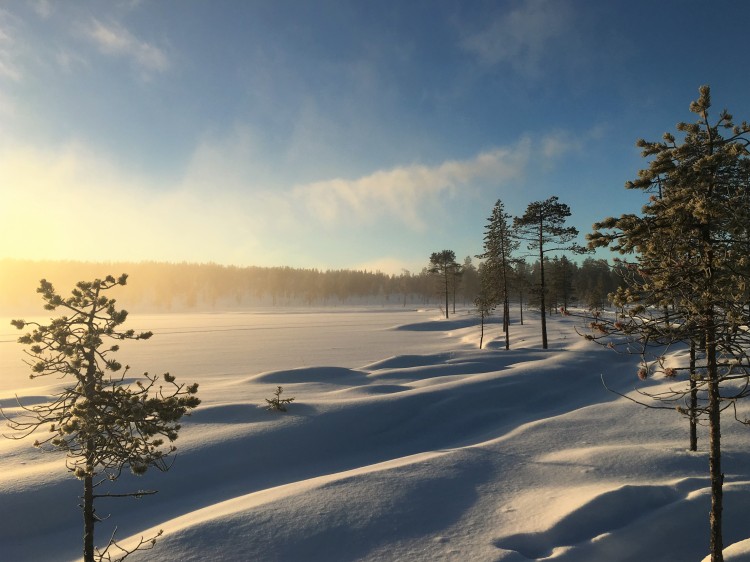I thought of this post as a follow up to Losing weight from last summer, which has turned out to be an article that still gets a lot of views.
I’m by no means an expert when it comes to packing or winter hikes but I’m always putting some effort in planning what to bring. Of course the expectations on packweight in wintertime have to to be lower than in the summer months. There is no chance to go for a week long trekking with a backpack of under 10 kg (22 lbs).
… At least not if you want to go for a winter hike on Swedish Kungsleden. Being located north of the Polar Circle, winter demands quite a bit of different equipment than summer.
Here’s what my gear looks like:

As you can see I’m not using a packpack but a pulk. When moving on a relatively flat trail and through the snow, a pulk makes hiking with snowshoes or skis way easier. It’s not the perfect option for steep, alpine terrain of course. On many stages of Kungsleden there is no more than +200 m (660 ft) positive climb per day, so it’s fairly easy to drag the pulk uphill (or go downhill, for that matter).
My pulk is from Fjellpulken and has a maximum volume of 285 liters (75 gallons). This is the specification given by the brand and I wouldn’t load it that much. If the sled is packed up high, the risk of it tipping over is constant and with all the weight it could break the pole system, which is made from fiberglass. The pulka itself is around 5 kg (11 lbs).
Is the pulk light? No. But: I don’t have to carry it on my back.
Here’s a picture of the packed sled. With shelter, kitchen, other equipment and food for two persons for two weeks it’s about 25 kg (55 lbs). We’ll each have a small backpack with spare clothes and personal belongings. 25 kg doesn’t sound like I’m even trying to go light but on many swedish or norwegian outdoors documentaries I watch, adventurers state to have a 80 kg+ (176 lbs) with them. That being said, I don’t want to compare my modest hike to a proper expedition.
Because of the warm clothes and extra equipment I need, there is no chance that it would fit my lightweight 60l backpack. While in summer there is a certain thought of reducing some weight by lowering the in-camp comfort, winter has very different safety concerns. Temperatures sometimes go down to -40°C (-40°F) but typically range around -5°C (23°F) to -20°C (-4°F) degrees throughout the winter.

As a shelter I’m bringing a spacy Hilleberg Nammatj 3 GT. It is absolutely storm proof and can handle a lot of snowfall without putting the tentpoles or the ventilation at risk. Due to it’s extended vestibule it’s possible to cook indoors, which, on many days, is an absolut necessity. The Nammatj is around 4 kg (8.8 lbs).

I do have lighter and smaller tents for two persons (a MSR Elixir and a Big Agnes Fly Creek) but I would never ever even think about using them for this type of adventure. Maybe something one can disagree on?
Since normal tent pegs don’t hold in snow, we will partly use our skis and ski poles and also a bunch of Hilleberg snow pegs. I don’t bring too many of these, both because they are heavy and incredibly expensive. For a pack of 6 pegs you could spend a night in a reasonable hotel.

What more do I bring?
- Sleeping bag: Mammut Tyin 5 Season (-25°C). It’s a synthetic sleeping bag, which makes it above anything else bulky. Especially this model is rather hard to compress and takes a shitload of space in the pulk. But sometimes you have to compromise and I just can’t go and buy an expedition down sleeping bag. Half the volume, half the weight but it would be at least 700€. Because I’m a person that freezes very easily I bring a thin Haglöfs L.I.M. down +1 sleeping bag as a liner. It’s only 450 g (1 lb).
- Sleeping pad: Exped winterlite M. (Finally an actual lightweight product on my list!) R-Value 4.90 and no more than 405 g (14 oz). For safety reasons we also have one Thermarest Z-lite which is even perfect for a lunchbreak in the snow and has the same weight as the Exped.
- Stove: Primus Omnifuel. Winter is not the season for my 72 g (2.5 oz) Optimus Crux Lite. We will need to melt snow for drinking and gas canisters are just not reliable in this kind of temperatures. The Primus Omnifuel is not to be considered lightweight but is with 350 g (12.3 oz) not too heavy either. We’ll bring 1 l of Primus Powerfuel which should be enough for 14 days. I won’t use the small pot but a bigger one to make melting snow more efficient.

- Navigation: Paper maps, a Silva ranger compass, my iPhone 6s with offline maps and a 20.000 mAh powerbank. On the ~180 km (112 miles) we are planning to hike, there will be only one point with cell phone reception. So my phone will mostly be used as a camera and to make GPS tracks. The powerbank is sufficient for 5 -7 charges.
- Clothes: I have learned to save a lot of weight and space on clothes. Having a bunch of different shirts, sweaters, jackets, underwear and pants is something we all are used to in our daily lives – but it is not necessary. During hiking I’ll wear: wool socks, long wool underpants, goretex pants, longsleeve wool shirt, a fleece hoodie and a goretex jacket, gloves, balaclava and a hat. Extra clothes I’ll have in the pulka: A down jacket (Mountain Equipment Cho Oyu expedition jacket, the warmest piece of garment on earth), a insulated skirt (nice to wear over my pants when taking a break or even at night), extra socks, another pair of long underwear and another wool longsleeve. I haven’t decided yet if I’ll bring a pair of shoes besides my skiing boots. Any ideas?

- Skiing equipment: Fischer E99 backcountry skis, Leki Haute Route skiing poles, Alpina Alaska boots, long skins for uphills.

- Food: Freeze dried, more freeze dried, soups, couscous, potato mash, olive oil, nuts, dried fruit, cereal bars, milk powder, Nestum breakfast flakes, hot chocolate, tea, sweets. There will be some huts on our way that sell food supplies and we’ll buy heavy stuff like canned meatballs or tuna on the day we consume it.
- Other gear: Black Diamond Spot headlamp, Julbo Zebra photocromic sunglasses, a snow shovel, 5 m rope in case the hauling system of the pulk breaks, alloy cutlery, a Mora knife, Black Diamond Orbit lantern, Outdoor Research Water Bottle Parka (had to google it, that’s the actual name), first aid kit, thermo bottle with mugs, personal hygiene, sunscreen and anti-frostbite stick and and ACR Personal Locator Beacon in case the shit hits the fan.
In conclusion, here’s what I’m saving weight with: If financially possible I use light, high quality gear. I bring very little spare clothes – no extra cozy sweater just because it’s nice to change clothes every day. No heavy camera, no books, no fishing equipment (an ice auger is the heaviest thing that exists), no shampoo, soap, detergent, no extra plates, bowls or other kitchen equipment. All the food I bring is very light and packs down small. Food at the huts is expensive because it gets transported there by scooter or helicopter, we’ll still buy around half of our supplies along the trail in order to save weight.
What I can improve: Gaining more experience in camping in wintertime! Get a smaller, warmer, lighter sleeping bag.




Try like these: http://www.outnorth.se/western-mountaineering/down-bootie-20371#Navy
LikeLike
Ser bra ut, tack!
LikeLike
Go tur Sara !
LikeLike
Tack så mycket! 🙂
LikeLike
Vad använder du för kartor och navigeringsprogram i din iPhone? Btw, du känner säkert till dem, men Cumulus har prisvärda sovsäckar om/när du ska uppgradera till en dunsäck för midvinterbruk.
LikeLike
Jag använder Wikiloc med offline kartor för att laga GPS spår och den nya fjällkartan appen för att kolla vart jag är.
Cumulus har jag hört av, har en 3- säsongers sovsäck från Roberts, som har samma koncept och kommer också från Polen.
LikeLike